
As businesses increasingly turn their focus toward sustainability, carbon accounting software is becoming a vital tool in their arsenal. These digital platforms measure, analyze, and manage a company's greenhouse gas emissions, and guide them in designing effective decarbonization strategies.
Below, we list the top 14+ carbon accounting software tools in 2024, shedding light on their key features, clients they cater to, and pricing models.
Each of these comes with its unique capabilities, from detailed emissions analysis to automated, compliant reporting, facilitating businesses on their path to environmental sustainability.
Whether you're a start-up or an established enterprise, this guide will aid in your quest for the best carbon accounting software tool in 2024. Let's dive in to understand what each has to offer, but first…
Carbon accounting, also known as greenhouse gas accounting, is the process of calculating the total amount of carbon dioxide (CO2) emitted by your company. Like financial accounting, it allows you to quantify the impact of your business activities, but instead of financial impact, it focuses on environmental impact.
By translating your business’s environmental impact into numbers, you can bring more accountability to your sustainability efforts. This gives stakeholders like customers, investors, and employees something tangible to support and evaluate your progress. It also makes it easier to identify reduction opportunities and comply with evolving regulatory requirements.
Carbon accounting software is a digital solution designed to measure, analyze, and manage greenhouse gas emissions that a company produces through its operations. These emissions are categorized into:
As compliance with global regulatory standards such as the EU CSRD (Corporate Sustainability Reporting Directive) and TCFD (Task Force on Climate-related Financial Disclosures) becomes crucial, carbon accounting software helps in transparent and efficient reporting.
In addition to facilitating compliance, these platforms can enhance a company's ability to attract talent seeking environmentally responsible employers.
Engaging stakeholders - from suppliers and partners to customers - is another key benefit, allowing them to better understand a company's commitment to sustainability and, in turn, fostering stronger relationships.
Choosing the right carbon accounting software can be a decisive factor in an organization's sustainability journey. This choice extends beyond merely selecting a tool for tracking emissions – it's about finding a comprehensive solution that aligns with your company's environmental commitment and business objectives.
Without the correct software, businesses risk non-compliance, potential fines, and a damaged reputation.
The right software can also support strategic decision making by providing valuable insights into a company's carbon intensity. It will highlight areas for improvement and assist in creating effective decarbonization strategies, fostering a proactive approach to carbon reduction.
These insights can be a powerful driver of innovation and trigger new, future-proof approaches to conducting business. Without further ado, here’s our list of the best carbon accounting software of 2024.
While the growing adoption of carbon accounting is a great step towards tackling the climate crisis, measuring carbon emissions is a complex process.
Using standardized frameworks like the Greenhouse Gas (GHG) Protocol or Carbon Disclorure Project (CDP) can give you the tools to measure these emissions effectively. This ensures your efforts align with the latest industry standards for accuracy and comparability.
However, for smaller companies without a well-resourced sustainability team, tackling carbon accounting in house can be a time-consuming and expensive process. Plus, relying on old-school spreadsheets is also error prone.
Carbon accounting software is designed to streamline, digitize, and automate the process. It turns a somewhat overwhelming task into something manageable – allowing you to focus your efforts on reducing emissions, with peace of mind that your accounting is accurate.
When selecting carbon accounting software for your business, there are several factors to consider:

Coolset’s automated carbon accounting software helps businesses measure, analyze, reduce and remove their emissions across Scope 1, 2 and 3. Beyond measurements and analysis, Coolset enables businesses to dive deep into their data, uncovering emissions hotspots and providing sustainable alternatives at every level, from top categories down to single vendors.
It also helps companies to get CSRD compliant, with a built-in double materiality assessment feature and source referenced ESRS topic disclosures.
Amsterdam, Netherlands
Start-ups, scale-ups and SMEs
Financial analyst or sustainability associate
€4.000 – €30.000, zero implementation fees
{{custom-cta}}

Watershed is an enterprise climate platform designed to support large companies in measuring, reporting, and reducing their carbon emissions. It helps businesses to map out their carbon footprint, prepare reports compliant with global regulatory standards, and set targets and track progress to reduce emissions.
It also ensures emissions data is auditable to power business value creation, regulatory compliance, and global climate impact.
San Francisco, California, United States
The world’s largest companies
Developer resources and climate leaders
€35.000 – €250.000, excluding implementation fees

Persefoni is an AI-powered carbon measurement and reporting platform that helps businesses to measure, report, and decarbonize. Ideal for large enterprises and financial institutions, it offers assurance-grade emissions reporting for every major climate disclosure regulation. It also helps with net-zero target setting and other tools for advanced decarbonization.
Tempe, Arizona, United States
The world’s largest enterprises and financial institutions
Developer resources and climate leaders
€45.000 – €300.000, excluding implementation fees

SINAI is a decarbonization platform that enables companies to go beyond carbon accounting and take action with cost-effective carbon reduction strategies. They provide enterprise software to measure, analyze, price, and reduce emissions, using science-based targets.
The tool includes functionalities like calculating scope 1-3 emissions, forecasting future emissions, identifying reduction opportunities, and carbon pricing.
Website
San Francisco, California, USA
Enterprises in heavy industries
Sustainability leaders, project managers
€25.000 – €200.000, excluding implementation fees

Normative helps industrial businesses measure exactly how much emissions they generate. Like in traditional accounting, Normative’s carbon accounting combines hard data and rigorous calculations to deliver reliable results. Normative’s Climate Strategists help to identify emissions reduction opportunities, minimize climate risk, and find opportunities for growth in a net-zero economy.
The company is all about making carbon emissions visible for everyone, enabling businesses to see emissions, plan reductions, and achieve net zero.
Stockholm, Sweden
Industrial technology enterprises
Sustainability leaders, data analysts
€60.000 – €180.000, excluding implementation fees

SmartTrackers is a multifunctional sustainability platform that helps businesses to measure and assess sustainability, safety, and CO2. It gives organizations insight into their environmental impact, simplifies accountability, and ensures they meet best practices, standards, and regulations. The tool focuses on customizability and manual entries to ensure maximum flexibility in data inputs.
Amersfoort, Netherlands
Enterprises
Sustainability managers, manual data entry
€1.900 – €28.500, excluding implementation fees

Plan A is a corporate decarbonization and ESG optimization software solutions provider. The German SaaS platform combines technology and the latest scientific standards and methodologies to align organizations on their sustainability ambitions. Business's can carry out their entire net zero journey within a single platform, from collecting and processing data to reporting and reducing emissions.
Berlin, Germany
Enterprises
Sustainability managers
€3.400 – €60.000, excluding implementation fees
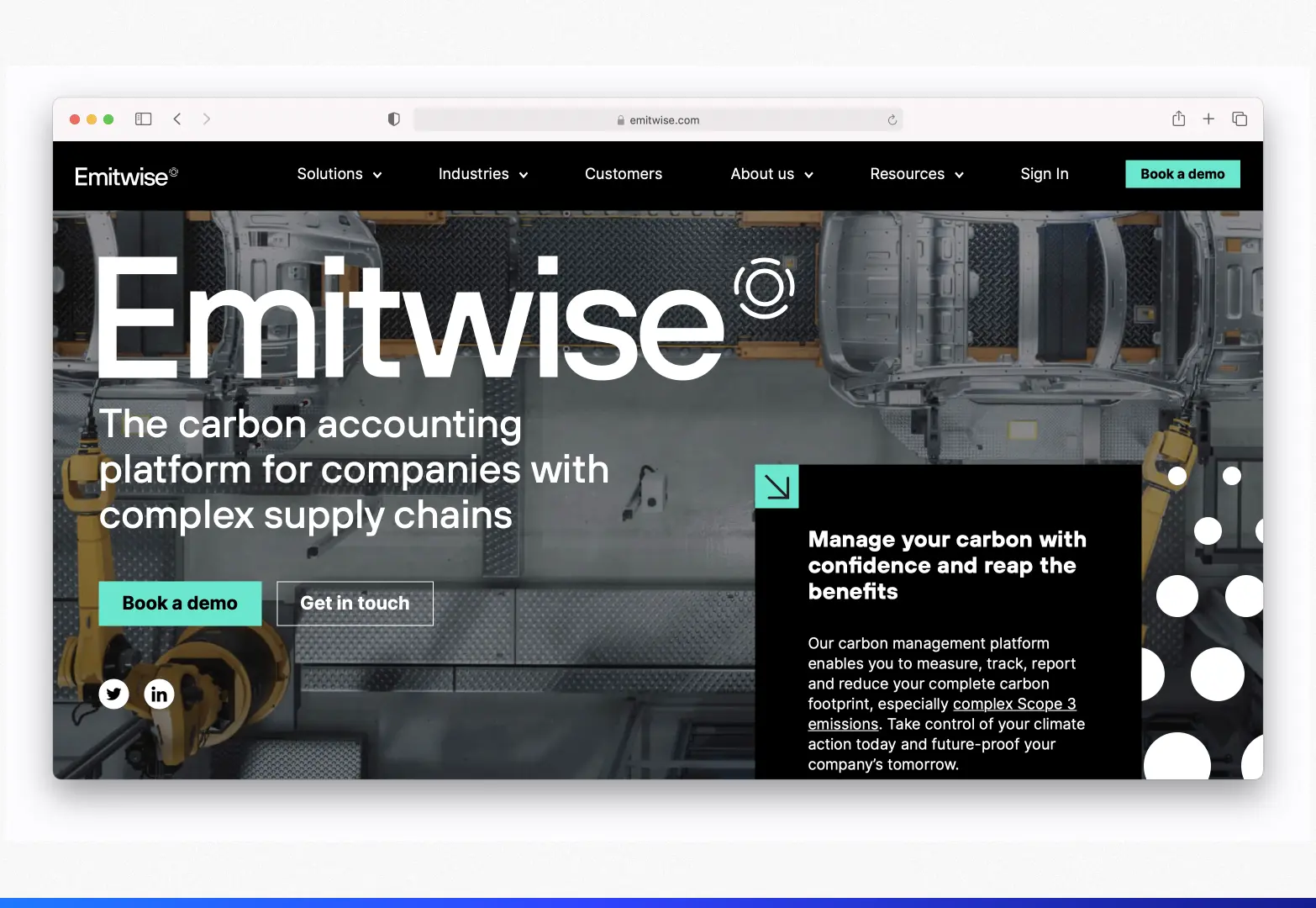
Emitwise provides a carbon management platform to help enterprises measure, track, report, and reduce their carbon footprint, especially complex Scope 3 emissions. From using machine learning to automate data processing to giving you data to make smarter procurement decisions, Emitwise prides itself on doing the heavy lifting for businesses. Their ultimate mission is to help businesses respond to the climate emergency by enabling manufacturers to drive their own carbon agenda.
London, United Kingdom
Companies with complex supply chains
Quality managers, sustainability leaders
€40.000 – €120.000, excluding implementation fees
{custom-cta}
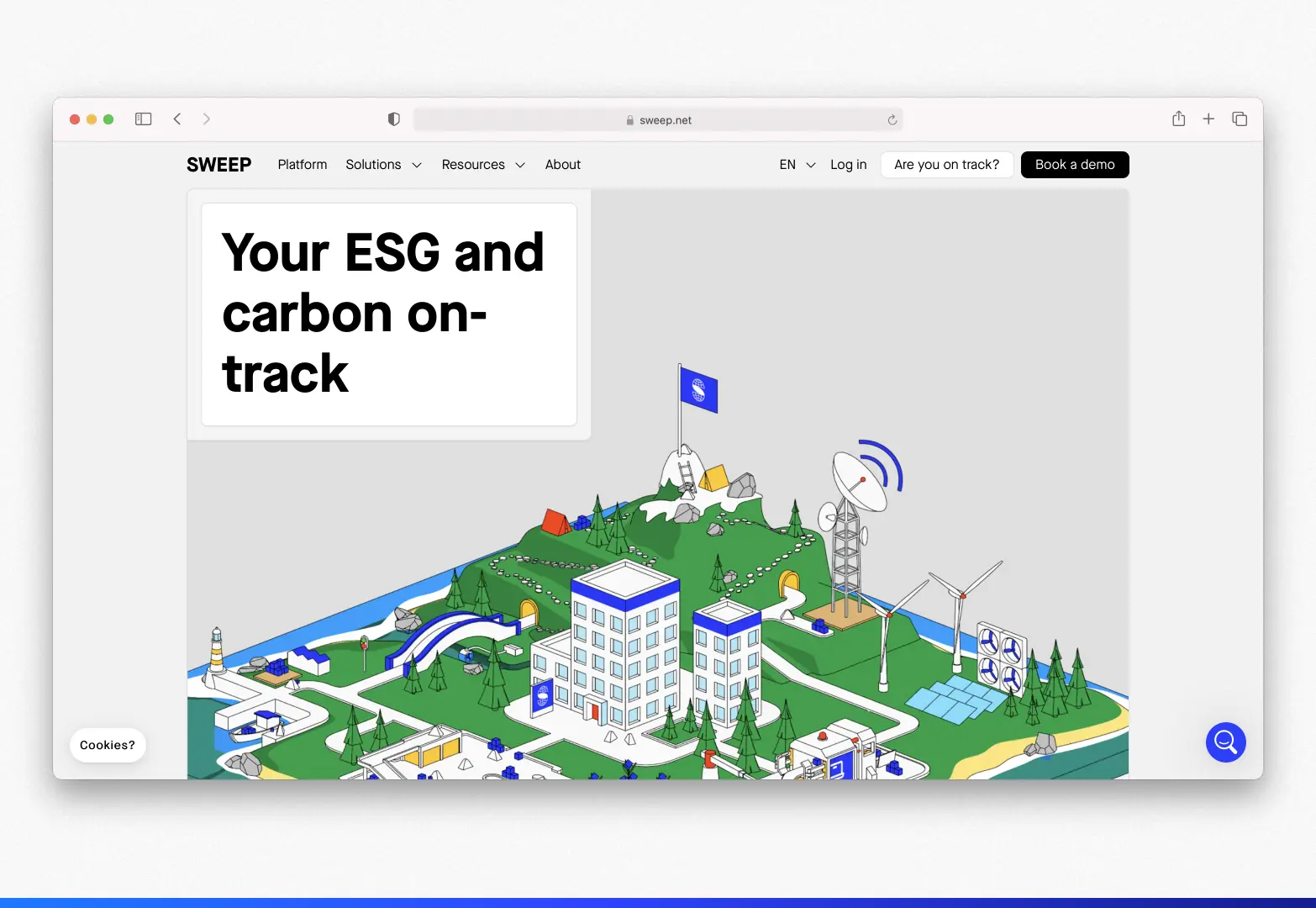
Sweep's carbon and ESG data platform helps large enterprises track, disclose, and act on their carbon emissions. The data-driven platform makes it easy to measure emissions, take action to reduce your carbon footprint, and collaborate with supply chain partners to drive measurable change.
Paris, France
Large enterprises and financial institutions
Sustainability leaders, development teams
€35.000 – €200.000, excluding implementation fees
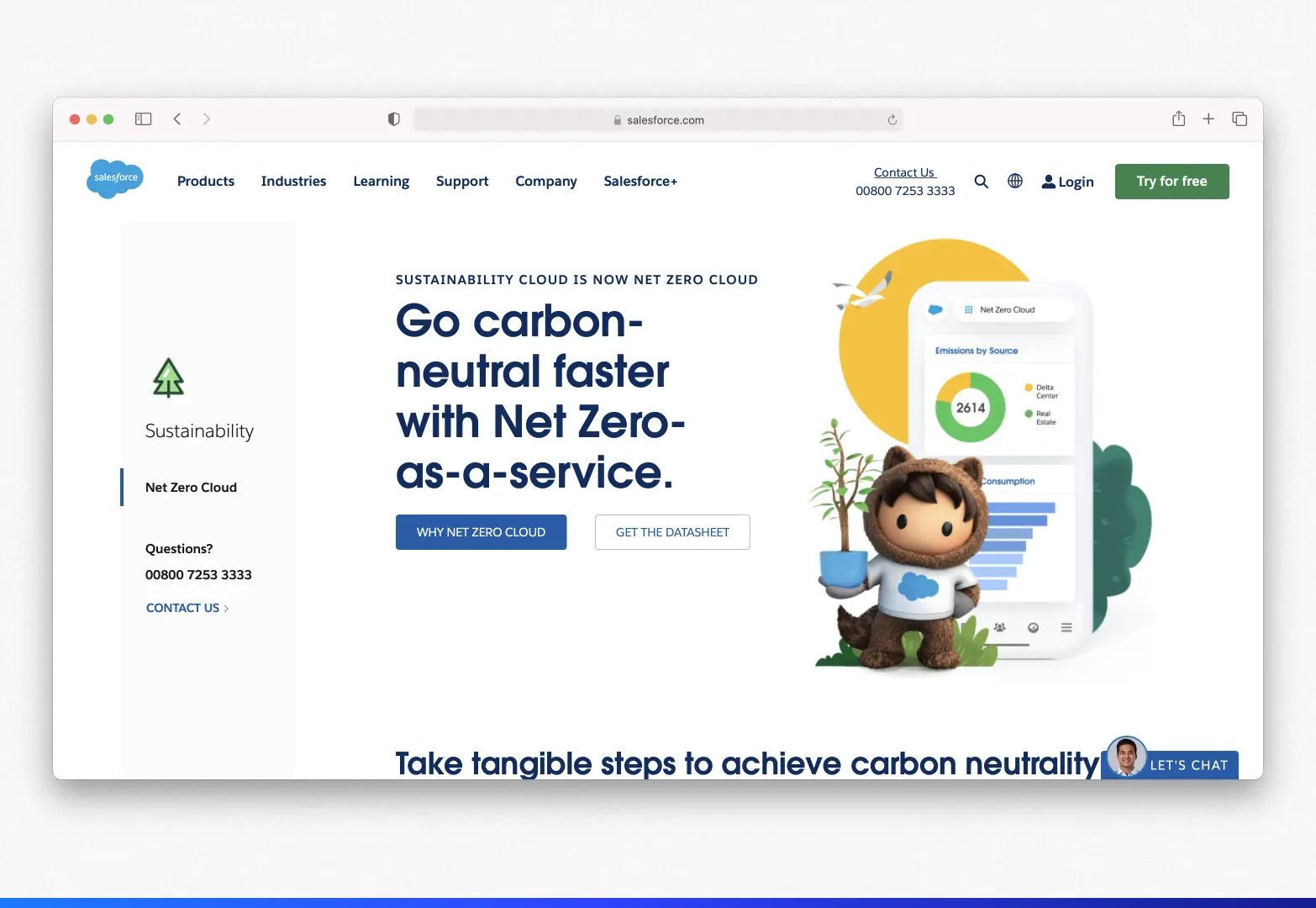
Salesforce's Net Zero Cloud helps businesses achieve carbon neutrality. It provides tools for tracking and analyzing carbon emissions across all scopes, facilitating the creation of a climate action plan. It's all about helping businesses to become carbon-neutral faster, offering practical steps to formulate a climate action plan and reduce emissions.
https://www.salesforce.com/eu/products/net-zero-cloud/overview/
San Francisco, California, USA
Large enterprises, Salesforce customers
Salesforce consultants or Force developers
€40.000 – €250.000, excluding implementation fees

Microsoft Cloud for Sustainability centralizes data for improved reporting, facilitates the creation of sustainable IT infrastructure, and reduces the environmental footprint of operations. Additionally, it promotes accountable value chains and simplifies emissions tracking through automated data collection and predefined calculation models. The platform is all about empowering businesses to accelerate sustainability progress and drive business growth.
https://www.microsoft.com/en-us/sustainability/cloud
Redmond, Washington, United States
Microsoft Azure enterprise customers
Sustainability managers, software developers
From €4.000 per tenant
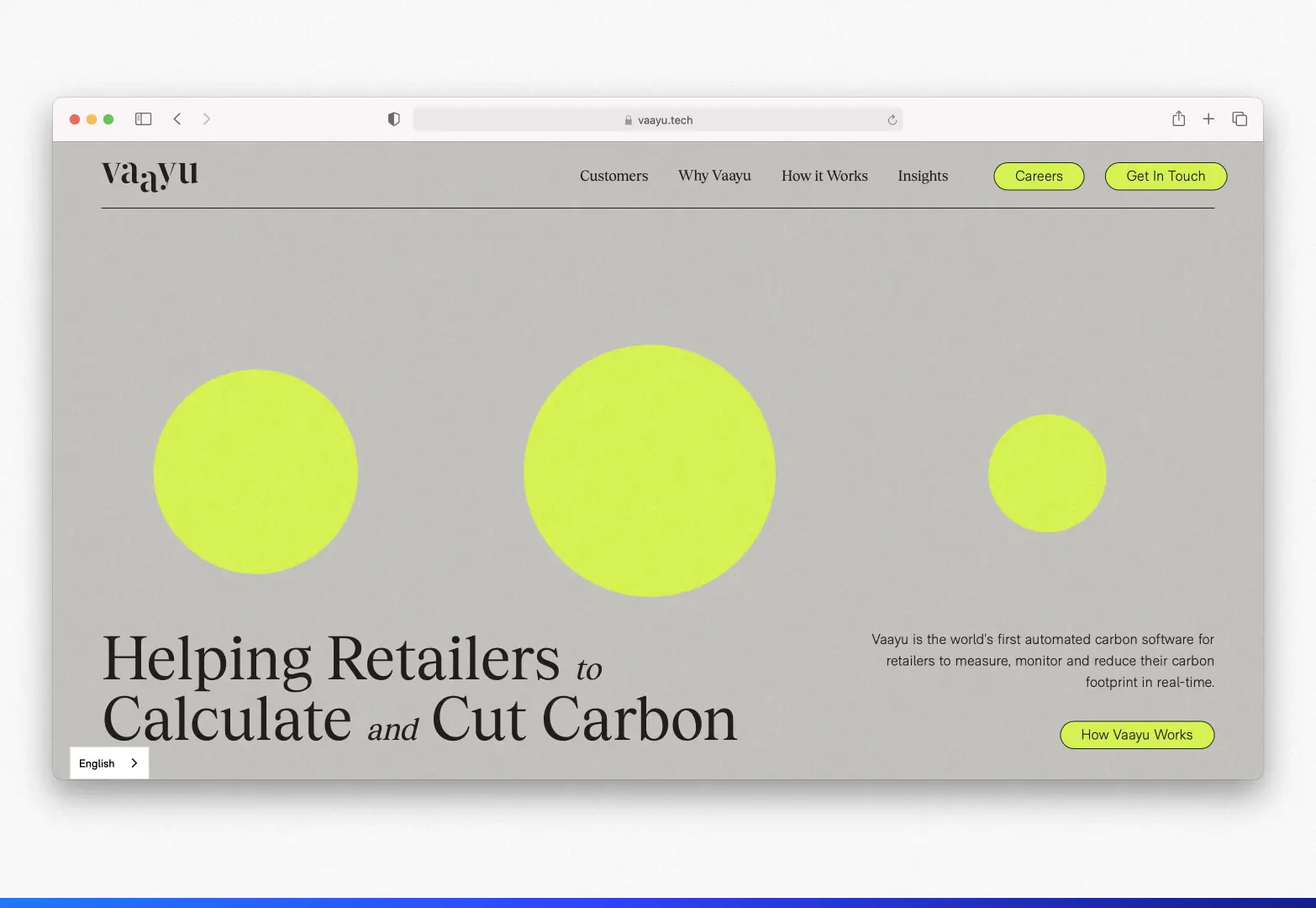
Vaayu provides automated carbon management software for retailers to measure, monitor and reduce their carbon footprint in real time. It focuses on product footprints and consumer-facing products to unlock commercial value from sustainability. With the help of AI and machine learning, the platform automates impact calculations. It also offers granular insights to aid decision-making and ensure regulatory compliance.
Berlin, Germany
Retailers across all business sizes
Sustainability managers, developers
€18.000 – €100.000, excluding implementation fees
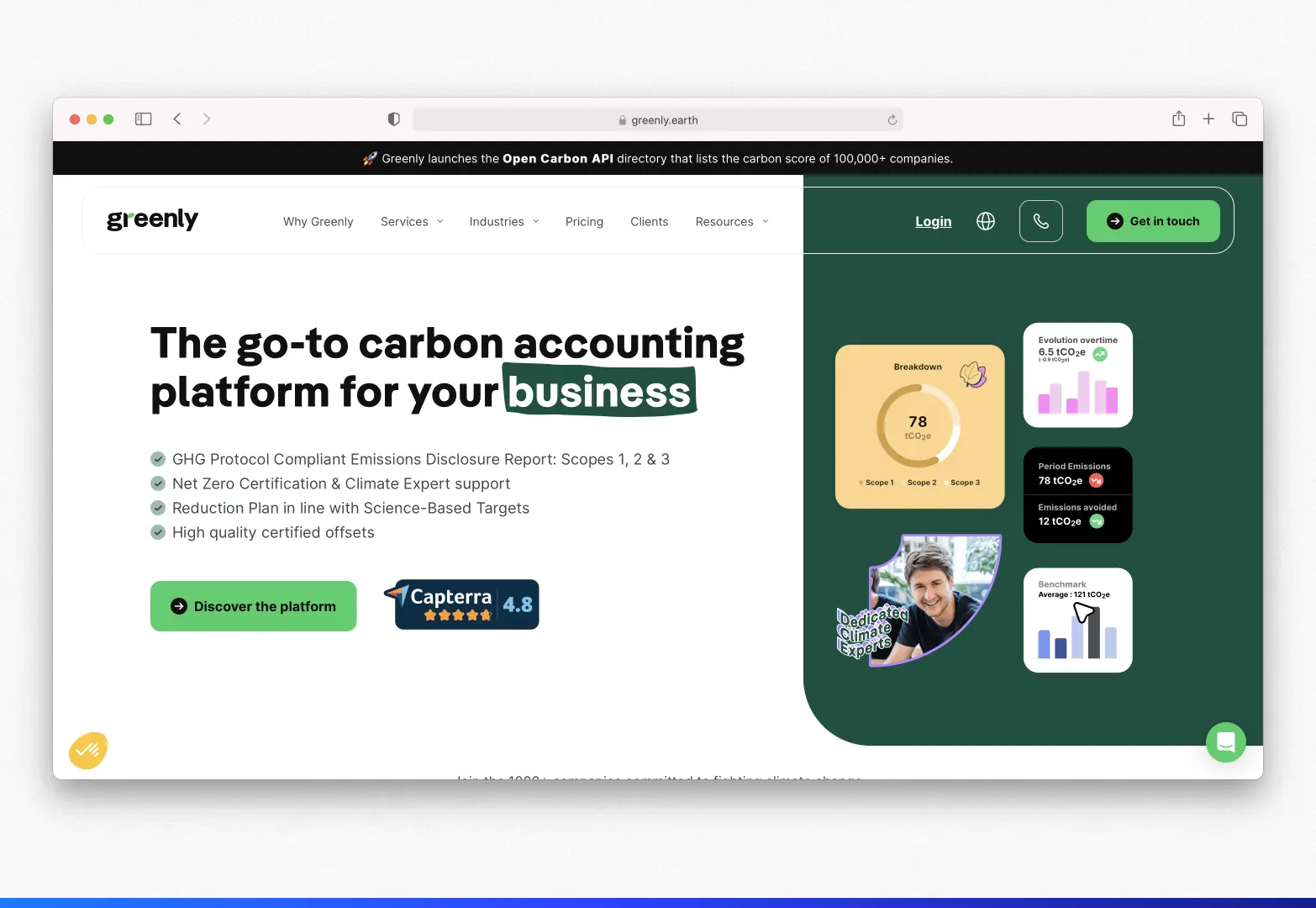
Greenly is a carbon accounting platform that aims to make carbon assessment and management simple. It enables companies to measure, monitor, reduce, and offset their carbon footprints based on international carbon accounting standards such as the GHG Protocol. It also helps businesses to engage their ecosystem, from employees to suppliers, throughout their climate journey.
Website
Location
New York, NY, USA
Clients
Small businesses to large enterprises
Company resources required
Sustainability manager
Key features
Pricing
€1.000 – €80.000, excluding implementation fees and add-ons

Sustain Life provides sustainability software for businesses to measure, manage, and report carbon emissions and make business decisions with the environment in mind. It works through consulting and accounting partners to serve global customers. From offering actionable insights to building reduction plans and streamlining reporting, it helps businesses on their path to net-zero.
New York, NY, USA
Small businesses to large enterprises
Sustainability manager, developer capacity
€5.000 – €60.000, excluding implementation fees

Pledge is a big believer in the power of technology in the fight against climate change. It provides tools and infrastructure to automate the delivery of climate solutions such as accredited footprint measurement, reporting, and offsetting into customer journeys. Pledge focuses specifically and exclusively on transportation and logistics companies to calculate emissions from freight and other logistics operations.
London, England
Transport and logistics companies
Sustainability managers, logistics managers
€600 – €20.000, volume-based pricing
{{custom-cta}}
Let’s take a quick look at some of the most frequently asked questions when it comes to carbon accounting tools.
Choosing carbon accounting software involves considering several factors. Firstly, assess your organization's specific needs and goals related to carbon tracking. Look for software that can measure and monitor emissions relevant to your industry or operations.
Consider the software's reporting capabilities, data integration features, and ease of use. Additionally, check if the software aligns with recognized carbon accounting standards like the Greenhouse Gas Protocol or ISO 14064.
The most widely used carbon accounting method is the Greenhouse Gas Protocol (GHG Protocol). It is a globally accepted standard developed by the World Resources Institute (WRI) and the World Business Council for Sustainable Development (WBCSD).
The GHG Protocol categorizes emissions into three scopes:
Carbon accounting can be accurate when based on reliable data and well-established methodologies such as the GHG Protocol.
The accuracy depends on the quality of data collected, the comprehensiveness of the methodology used, and the implementation of robust tracking and reporting processes. Regular audits and verification can further enhance the accuracy of carbon accounting results.
Carbon accounting is not the same as financial accounting. Financial accounting focuses on tracking and reporting an organization's financial transactions and performance, including revenues, expenses, and profits.
On the other hand, carbon accounting deals with measuring and managing an organization's greenhouse gas emissions and environmental impact, with the aim of understanding and reducing its carbon footprint.
Carbon accounting and GHG accounting are often used interchangeably, but there is a subtle difference between the two.
Carbon accounting typically refers to the specific measurement and management of carbon dioxide (CO2) emissions, while GHG accounting covers a broader scope, including all greenhouse gas emissions like methane (CH4), nitrous oxide (N2O), hydrofluorocarbons (HFCs), and others.
One of the most notable and successful carbon capture projects is the "Sleipner Project" in Norway. Operated by Equinor (formerly Statoil), the Sleipner Project has been in operation since 1996. It involves capturing and storing approximately one million tons of CO2 annually from a natural gas field in the North Sea by injecting it into a deep saline aquifer.
Two prominent carbon sequestration methods are afforestation/reforestation and carbon capture and storage (CCS). Afforestation involves planting trees on land that was not previously forested, while reforestation focuses on replanting trees on areas that were previously deforested.
CCS, as mentioned earlier, involves capturing CO2 emissions from industrial processes or power plants and permanently storing them in geological formations underground.
Collecting data for carbon accounting typically involves gathering information on energy consumption, fuel usage, transportation, waste generation, and other activities that result in greenhouse gas emissions.
Data can be collected through various means, such as utility bills, emission factors for fuels, activity data, and direct measurements using sensors or monitoring equipment. Get in touch with Coolset if you’d like to find out more.
The cost of carbon accounting can vary depending on the scale of the organization and the complexity of its operations.
Some carbon accounting software may have subscription-based pricing, while others may charge based on the number of emissions sources being tracked or the volume of data processed. Additionally, costs may include training, implementation, and, if desired, third-party verification expenses.
The future of carbon accounting is likely to be increasingly important as the world shifts towards more sustainable practices and governments implement stricter regulations on carbon emissions.
Advances in technology and data collection methods may lead to more accurate and automated carbon accounting processes. Integration of carbon accounting with broader sustainability metrics and reporting will also be a trend in the future.
An example of carbon accounting is a multinational company tracking its carbon emissions across various subsidiaries and operations worldwide.
By using carbon accounting software like Coolset, the company can monitor emissions from its manufacturing plants, offices, transportation fleet, and supply chain.
The data collected enables the company to identify emission hotspots, set reduction targets, and develop strategies to minimize its overall carbon footprint, contributing to its sustainability goals and corporate social responsibility initiatives.
The best carbon accounting software for your business will streamline emission tracking and management. It should provide detailed Scope 1, 2, and 3 emission measurements and enable deep insights into your carbon footprint.
A good example is Coolset, which offers granular breakdowns on emission hotspot categories, high impact vendors and single transactions, empowering informed decarbonization strategies.
The platform should integrate a comprehensive emission factor database and employ advanced automation for accurate and reliable measurements, ensuring GHG protocol compliance. It should also allow for proactive emission reduction planning, with features like a net zero strategy builder, emission deep-dives, automated reporting and progress tracking.
Certified carbon offset offerings and actionable reduction recommendations are key features to look for, allowing businesses to balance unavoidable emissions and move closer to their net zero goals. The software should also facilitate easy compliance with upcoming regulatory standards such as the EU CSRD.
Finally, consider the provider's commitment to long-term partnerships. The best software is backed by a team that’s ready to assist with setup and ongoing use, serving as a valuable partner in your upcoming sustainability journey.
Try Coolset's carbon accounting software tool

Try Coolset's carbon accounting software tool
Get the latest updates on events, guides, market trends and product advancements.
Streamline sustainability measurements, improvements and compliance in one place.
